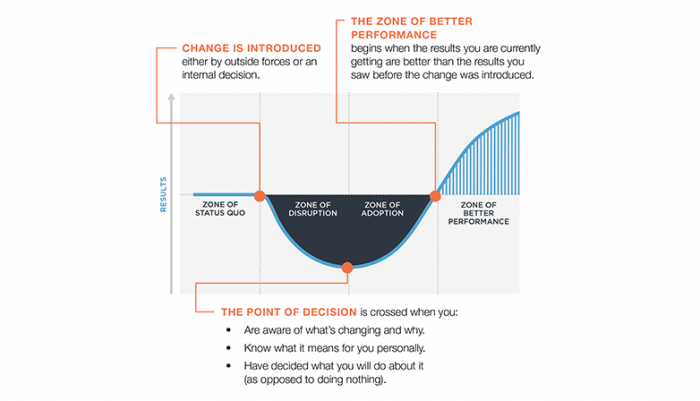Practice 5: Lead Your Team Through Change

Turn uncertainty into opportunity.
Great leaders must lead change, even when it originates from the corporate office, outside consultants, customer demands, economic turmoil, or competitors. And as a first-level leader, most of the change they face will be someone else’s idea.
Plenty of leaders can succeed during good times, but the true mettle of a leader emerges during times of uncertainty. When change comes their way (and it will), it is arguably one of the strongest tests of their leadership capability. Those leaders who show patience, stamina, emotional stability, resilience, and confidence are the most valuable to an organization and their team.
To effectively lead through change, leaders need to shift their mindset from ‘I control and contain change for my team’ to ‘I champion change with my team.’
The FranklinCovey Change Model
The outcomes of a change are often unpredictable, as are most people’s responses. The FranklinCovey Change Model is a tool to help all of us move through four common zones of adopting change.

Apply the Change Model
The Change Model applies logic and predictability to what can otherwise seem like a chaotic process. It’s a tool for diagnosing responses to ongoing change—for the team and the leader—and helping everyone navigate the roughest parts to achieve acceptance, ownership, and new levels of innovation.
Change is a sloppy process, but it can be better adopted with awareness of these four zones, especially if leaders can help make them short and shallow. Leaders can also use the model to diagnose where each team member is on the emotional curve at a given time. No two people respond to change in the same way or at the same rate. But when leaders can say, “Shawn is in Zone 3, but Megan is still stuck in Zone 2,” they can address issues on an individual basis.
Great leaders help their team members reach Zone 4 as quickly and smoothly as possible. Preparing for change in Zone 1 and managing emotions in Zones 2 and 3 will help ensure that their team’s change curve is short and shallow.
One caveat: change management is the subject of intense study and organizational-development dissertation. We’ve intentionally created a simple, clear, and actionable model that will help leaders navigate the emotional aspect of change.

People don’t resist change; they resist being changed.
Votre Guide Complet
100+ Questions pour de meilleurs entretiens individuels
Ce guide vous donnera toutes les questions clés pour réussir vos entretiens individuels.
Register for an Event
Everyone Deserves a Great Manager Webcast
Discover the proven best practices to develop your people into a high-performing team.
The 6 Critical Practices for Leading a Team™
Diriger une équipe exige un état d’esprit différent de celui d’un collaborateur individuel. Explorez les changements d’état d’esprit critiques qui maximiseront le succès en tant que leader des autres.
Augmentez l’engagement des membres de l’équipe en organisant régulièrement des entretiens individuels, approfondissez votre compréhension des problèmes des membres de l’équipe et aidez-les à les résoudre par eux-mêmes.
Créez la clarté sur les objectifs et les résultats de l’équipe ; déléguez la responsabilité aux membres de l’équipe tout en fournissant le bon niveau de soutien.
Donner du feedback pour développer la confiance et la compétence des membres de l’équipe ; améliorer ses propres performances en demandant le feedback des autres.
Identifiez des actions spécifiques pour aider les membres de l’équipe à naviguer, à accélérer le changement ainsi qu’à obtenir de meilleures performances.
Utilisez la planification hebdomadaire pour vous concentrer sur les priorités les plus importantes, et renforcez votre capacité à être un leader efficace en appliquant les 5 moteurs d’énergie.



